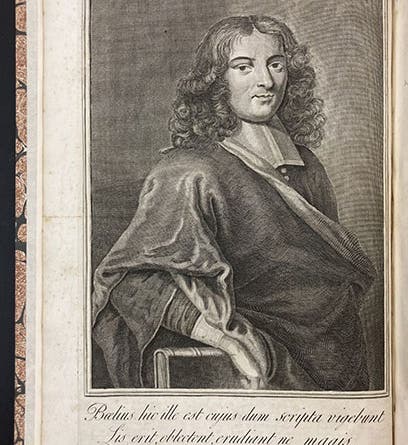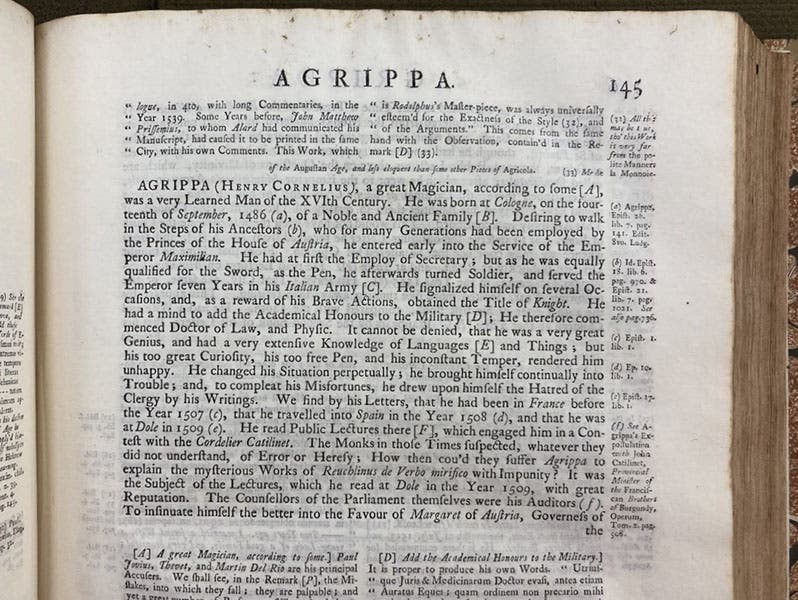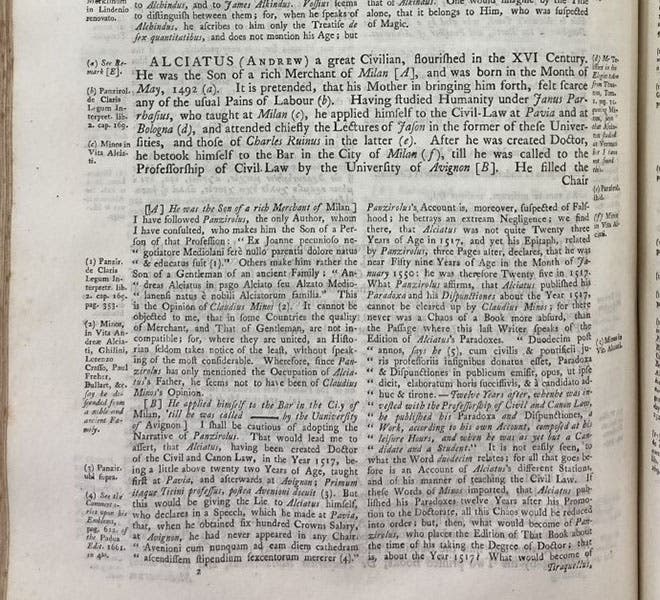Scientist of the Day - Pierre Bayle
Pierre Bayle, a French philosopher, was born Nov. 18, 1647. Bayle was born into a Protestant family in southernmost France, south of Toulouse, and he grew up at a time when the Huguenots, the original French Protestants, were being increasingly persecuted by authorities (Louis XIV would revoke the Edict of Nantes in 1685, outlawing Protestantism altogether in France). Bayle was educated in Switzerland, and in Jesuit schools (he even converted to Catholicism briefly, before unconverting). Eventually, he moved to the more tolerant (and Protestant) Netherlands, where he settled down in Rotterdam. He was offered several academic positions (and a wife), but he turned down all these offers so he could devote himself single-mindedly to writing. And what he proposed to write was a one-man biographical intellectual dictionary, with articles on any historic or living figure that he felt like writing about. Lo and behold, he did just that.
Bayle’s Dictionnaire historique et critique (A Historical and Critical Dictionary) was published in Rotterdam beginning in 1697, in four fat folio volumes. It proved to be immensely popular, and went through four editions by 1730. We have in our Library an English translation, published in five folio volumes in 1734-38, and as it is the only version at my disposal, our discussion will be generated by the translation.
The most striking feature of Bayle’s Dictionary is the skewed selection of subjects (there is no entry, for example, on René Descartes), but since that can only be appreciated by leafing through the table of contents and asking – who isn’t here? – we will skip to the second most visible feature, the proportion of text to footnotes. There are typically a half-dozen lines of text and 50 lines of notes on each page, an extreme proportion for even a dedicated scholar. Even some of the footnotes have footnotes. I show you several pages from the article on “Henry Cornelius Agrippa,” which I chose because this is a history-of-science blog, and Agrippa was a Renaissance naturalist, a defender of natural magic. One (third image) shows the opening of the article, and the second (fourth image) shows a later page of that article, with one line of text and the rest footnotes. The notes are a response to a statement in the one line of text: “There are some errors of fact in the manner of some persons apologizing for him.”
Bayle didn’t think much of Agrippa’s occult philosophy – if he had access to all the forces of nature, asked Bayle, why did he lead such a miserable life – but Bayle didn’t think much of any philosopher. Bayle was basically a sceptic, and that colored much of his prose. In his opinion, all rational proofs of anything whatsoever are flawed, and he delighted in finding the flaws. Since reason fails us at every turn, we can in the end have recourse only to faith. Bayle was surprisingly tolerant in matters of religion, in an age when intolerance was rampant. He was convinced that intolerance, especially as wielded by organized religion, breeds only ignorance, and that it is good for our faith, whatever it is, to be jostled by others who believe differently.
Bayle’s Dictionary was enormously popular in the Enlightenment (apparently all those luminaries of the Age of Reason did not realize that Bayle himself was anti-rationalist). David Hume in particular was quite taken by Bayle’s handiwork. Our English edition of Bayle's Dictionary is quite lovely, although, I must say, it is a bit unwieldy. Hume carried all five volumes of his edition wherever he went, but I found it a chore just to haul them from the vault to the reading table. It is no coincidence that all the pages I photographed were in volume 1.
We have several times in these posts made a reference to the Kansas City Public Library wall of books project, where they had members vote on their favorite books and then commissioned giant book spines of the winners for the front wall of their parking garage. All of the KCPL book spines were based on books in our collections. The spine of volume 4 of our set of Bayle’s Dictionary was used for the giant mock-up of the Collected Poems of Langston Hughes on the facade of the parking garage of the Kansas City Public Library (sixth image). For other examples of books from our collection used as models for KCPL book spines, see our posts on Joannes Jonston, Henry Bradbury, and Johann Glauber.
The engraved portrait of Bayle that appears in our copy of his Dictionary (first image) was based on an oil painting by Louis Ferdinard Elle the Younger. Here is that oil painting.
Dr. William B. Ashworth, Jr., Consultant for the History of Science, Linda Hall Library and Associate Professor emeritus, Department of History, University of Missouri-Kansas City. Comments or corrections are welcome; please direct to ashworthw@umkc.edu.











